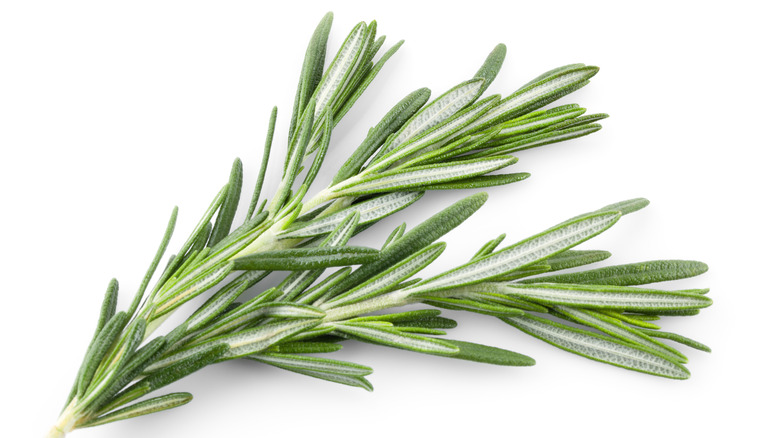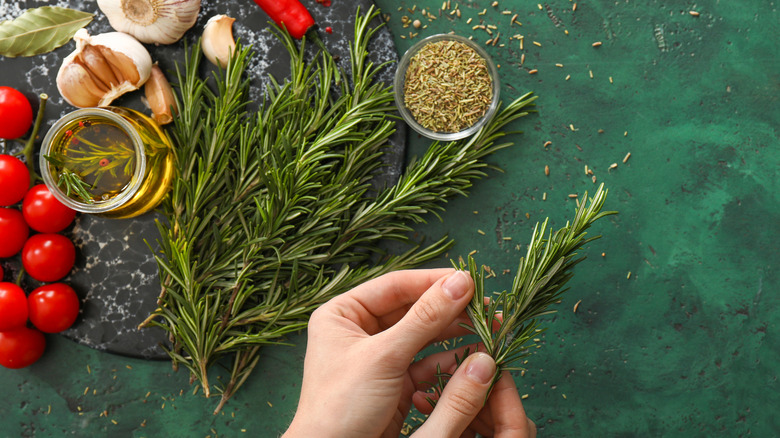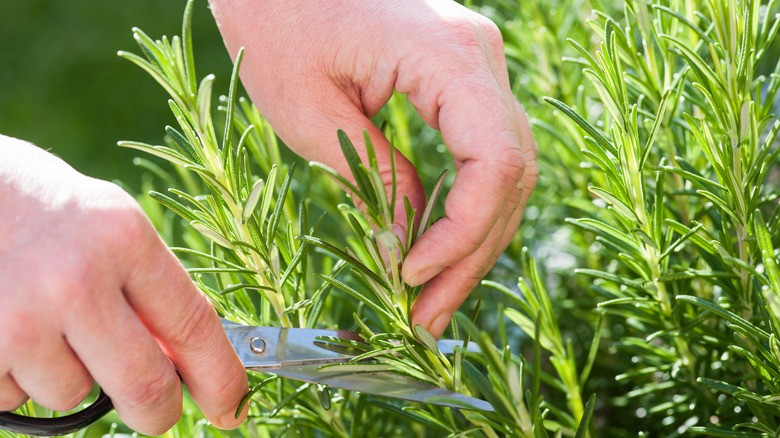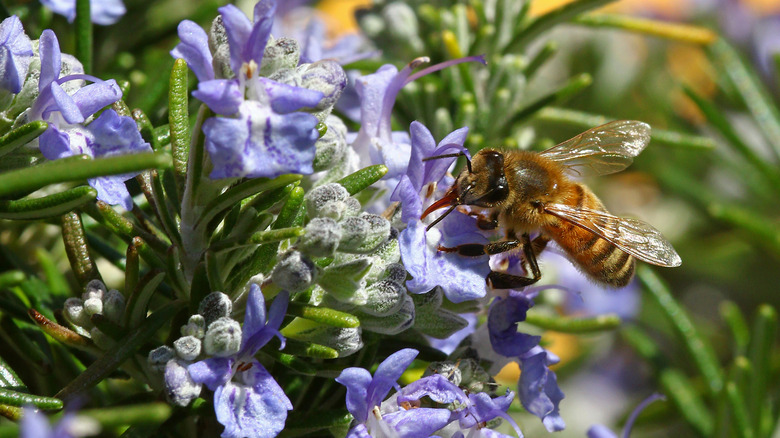Everything You Need To Know About Rosemary
Rosemary (rosemarinus officinalis) is a multi-tasker in the herb world. Popular among chefs for its savory (some say woodsy) flavor, the versatile indoor/outdoor perennial is also hailed for enhancing memory, aiding sleep, attracting bees, and repelling flies and mosquitoes.
Native to hilly regions in Europe and along the Mediterranean, rosemary is a branch of the mint family (via University of Wisconsin Extension Horticulture Program). In the wild, it grows into a shrub and can reach a height of up to six feet. While common lore suggests Roman soldiers brought rosemary to Britain in the first century, The Rosemary Specialist begs to differ, citing a lack of evidence connecting the herb to archeological digs at Roman sites in the U.K. and Europe. While its path around the world may be subject to debate, English Garden lists rosemary among the top 10 fresh herbs every cook should have in the kitchen. All varieties of rosemary are edible, but SFGate says some are more suited to cooking, while others thrive as ornamental shrubs. Two particular cultivars, Tuscan Blue and Spice Island, are chef favorites. As a rule of thumb, SFGate says plants that grow upright (rather than trailing) with broader leaves are the best choice for kitchen gardens.
What does rosemary taste like?
The flavor of rosemary can be woodsy and peppery. Simple30 says the aromatic herb has a flavor all its own but adds "bitter" to the list. You might also catch hints of evergreen, pine, citrus, mint, and sage in your rosemary. That's a big punch of flavor for the mighty herb known for its capacity to blossom in dishes like stews and braises that require extended cooking times. While rosemary is relatively easy to grow indoors, it's also readily available in dried form at most local grocery stores.
There are a few tips to know when it comes to substituting dried herbs for the garden-fresh variety. While more delicate herbs, like cilantro or tarragon, are often more flavorful in their fresh form, rosemary stands up well when it's dried. Keep in mind, the rosemary in the cooking aisle at your local grocery store is spindly, like a short, stocky pine needle. Chop it up before using it in a recipe to avoid brittle bits in the final product. And remember the 1:3 rule — use one part dried for every three parts fresh, per Reluctant Gourmet. For example, substitute a teaspoon of dried rosemary for a tablespoon of fresh rosemary.
What are the health benefits of rosemary?
Students in ancient Greece and Romans braided rosemary garlands into their hair to enhance memory (via Gardening Know How). They may have been onto something. Medical News Today cites research published in Therapeutic Advances in Psychopharmacology, a peer-reviewed open-access journal, connecting the scent of rosemary to improved concentration. That same article also references information from the National Center for Biotechnology Information, a research organization affiliated with the National Institutes of Health, suggesting the carnosic acid contained in rosemary protects against free radical damage to the brain, and may be useful in treating strokes and cerebral aging.
In an article about the olfactory benefits of rosemary, Garden Betty mentions a study by a team of scientists at the University of Northumbria in the U.K. Research revealed the oil that gives rosemary its unique scent enhances production of acetylcholine, a neurotransmitter found in both the central nervous system and the peripheral nervous system (via Verywell Mind). The effect is similar to that of some drugs used to treat dementia. Medical News Today also points to pain relief, circulatory and immune system health, anti-inflammatory properties, and eye health among the benefits of rosemary.
How to grow rosemary
Rosemary is an easy-to-grow, low-maintenance herb that thrives in most climates and is readily adaptable for both container and indoor gardening. Plants need well-drained soil and six to eight hours of sunlight per day. Drought-tolerant, according to Martha Stewart, rosemary does best in a porous potting blend. (Take care not to overwater.) You should forego seeds in favor of purchasing an established plant at a local garden shop. Starting from seed can be frustrating. Germination rates are low and seedlings are finicky (via The Old Farmer's Almanac).
Once you have a flourishing plant, you can expand your garden by cuttings. Rosemary thrives outdoors in USDA Plant Hardiness Zones 7–11. In cooler climates, move the plant to an indoor location before the first frost. The Old Farmer's Almanac warns plants don't transfer well from ground to container and back again, so consider transportable containers for year-round indoor-outdoor gardening. An option: Make your own dried rosemary. Delishably outlines the simple process. Start with cuttings clipped in the morning when oils in the leaves are strongest. Wash and dry the cuttings. Tie the stems into bundles of eight. Hang the bundles in a dark, dry place (like a closet) for about four weeks. Once you untie the bundles, you can strip the leaves, and store in a tightly sealed container.
Cooking with rosemary
Rosemary's potency belies its adaptability. A staple in Mediterranean-style braises and stews, it can also add a pop of savory flavor to everything from breads and desserts to cocktails and condiments. Spiceography offers a primer of do's and don'ts on cooking with rosemary including: Do chop rosemary leaves finely unless you're using whole sprigs, and do remember rosemary is a strong herb that can overpower other ingredients.
On the flip side, don't serve whole stems in finished dishes. Rosemary is a tasty complement to meat, poultry, and fish. It's also a common ingredient in vegetable dishes, especially peas, mushrooms, and potatoes. While rosemary has a distinct flavor that's difficult to replicate, a few substitutes will work in a pinch. Ready to cook? For inspiration, consider rosemary roasted potatoes from A Couple Cooks or try your hand at an easy slow cooker chicken with rosemary. The freshness of rosemary even works well in bright cocktails like a gin fizz (via Inspired Taste).
Alternative uses for rosemary
In aromatherapy circles, rosemary is known for easing anxiety and stress. Healthline cites a Meikai University study connecting the scent of rosemary to decreased levels of cortisol, known as the body's stress hormone. While the scent of fresh rosemary in your garden — or on your windowsill — can have a relaxing effect, it's also easy to make your own essential oil. Well + Good's recipe calls for just two ingredients, rosemary and olive oil. Combine the ingredients on the stovetop or seal them together in a mason jar and let nature take its course.
In the garden, rosemary attracts bees — and that's a good thing. As Medical News Today points out, the bee population worldwide has been on the decline. That's a bad thing. Without bees to pollinate them, food crops will die. A study by the University of Missouri Extension, per Country Living, confirmed rosemary (in addition to thyme and lavender) attract pollinating bees.
While it attracts bees, the smell of rosemary repels pesky flying insects like the mosquitoes and gnats that target us by scent. The Old Farmer's Almanac suggests throwing a few rosemary sprigs on the barbecue as you get ready to grill. Aromatherapy, flavor burst, and bug repellant all in one. Rosemary really is a multi-tasker in the herb world.





